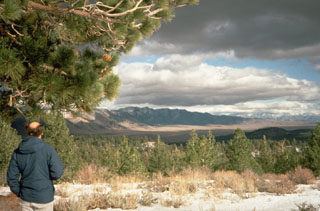Report on Long Valley (United States) — August 1989
Scientific Event Alert Network Bulletin, vol. 14, no. 8 (August 1989)
Managing Editor: Lindsay McClelland.
Long Valley (United States) Shallower seismicity; minor deformation
Please cite this report as:
Global Volcanism Program, 1989. Report on Long Valley (United States) (McClelland, L., ed.). Scientific Event Alert Network Bulletin, 14:8. Smithsonian Institution. https://doi.org/10.5479/si.GVP.SEAN198908-323822
Long Valley
United States
37.7°N, 118.87°W; summit elev. 3390 m
All times are local (unless otherwise noted)
The earthquake swarm was continuing in early September (figure 8). Most of the events have been small (M <1), with the largest, M 3.3, on 21 June. By 30 August, the state of California's NEWT system had recorded 1,150 swarm events, 193 in August. The USGS MMP station, in the epicentral area, continued to record several hundred shocks daily that were too weak (M <0.5) to be detected by other nearby instruments [but see SEAN BGVN 14:09]. A series of 37 earthquakes was recorded on 29 August, the 3rd largest daily total of the 4-month swarm. The epicenters for this day were still on the SW flank of Mammoth Mountain, but focal depths were only 2-4 km, compared to the 4-9 km typical of most previous swarm events.
The USGS Devil's Postpile dilatometer, roughly 4 km WNW of the epicentral area, has shown small changes that may be correlated with the Mammoth Mountain seismicity. Since its installation several years ago, it has recorded a slow compressional trend that typically accelerates in the fall and flattens in the spring, yielding a cumulative change of up to 5 ppm. The dilatometer has also measured occasional superimposed wavelets lasting two to a few days with amplitudes of roughly 0.5 microstrain. One such deviation occurred about three weeks before the onset of the swarm, and several others were apparently associated with bursts of seismicity during the swarm. The slow dilatation that had been occurring since late July began to level off ~1.5 days before the onset of the shallow 29 August events. At about the time they started, the dilatometer detected a distinct 1-2-hour perturbation that was a fraction of a tidal amplitude. Although the changes were small, their polarity is consistent with an intrusion beneath Mammoth Mountain.
Geological Summary. The large 17 x 32 km Long Valley caldera east of the central Sierra Nevada Range formed as a result of the voluminous Bishop Tuff eruption about 760,000 years ago. Resurgent doming in the central part of the caldera occurred shortly afterwards, followed by rhyolitic eruptions from the caldera moat and the eruption of rhyodacite from outer ring fracture vents, ending about 50,000 years ago. During early resurgent doming the caldera was filled with a large lake that left strandlines on the caldera walls and the resurgent dome island; the lake eventually drained through the Owens River Gorge. The caldera remains thermally active, with many hot springs and fumaroles, and has had significant deformation, seismicity, and other unrest in recent years. The late-Pleistocene to Holocene Inyo Craters cut the NW topographic rim of the caldera, and along with Mammoth Mountain on the SW topographic rim, are west of the structural caldera and are chemically and tectonically distinct from the Long Valley magmatic system.
Information Contacts: S. McNutt, California Division of Mines and Geology, Sacramento; D. Hill, USGS Menlo Park.

